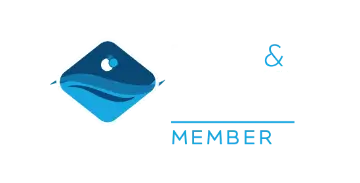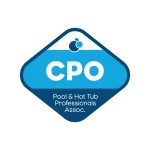Custom designed swimming pools are all individually unique in their shape and size, but what’s not unique is the need for proper sanitation of the water. There is A LOT of information on the Web relating to how to properly sanitize pool water but how do you know what’s applicable to your specific situation? Keep reading and perhaps you will see the answer you are looking to find.
First, lets discuss the different types of chlorine.
Sodium Hypochlorite is commonly known as liquid chlorine or ‘bleach’ as it is sometimes called. “Sodium hypochlorite is an alkaline inorganic chemical compound with the formula NaOCl. It is commonly known in a dilute aqueous solution as bleach or chlorine bleach. It is the sodium salt of hypochlorous acid, consisting of sodium cations and hypochlorite anions.” (https://en.wikipedia.org/wiki/Sodium_hypochlorite) This form of chlorine is very unstable and decomposes rapidly, especially in the presence of UV radiation (i.e. from the Sun). Sodium Hypochlorite is typically found in concentrations from 3% to slightly over 12% and rapidly degrades in the presence of oxygen, so beware of bottles that have sat on a shelf for too long. What you are buying could be degraded by 50% or more, hence making it ineffective as a pool sanitizer.
Secondly, Calcium Hypochlorite (aka ‘CalHypo’) is one of the more common types of chlorine used in swimming pool maintenance, especially when pool chlorine levels need to be increased rapidly. Calcium hypochlorite is an inorganic compound with chemical formula Ca(ClO)2, also written as Ca(OCl)2. It is a white solid usually found in granular or powder form when used for swimming pool sanitation. The compound strongly smells of chlorine, arising from its slow decomposition in humid air. This compound is relatively stable as a solid and solution and has greater available chlorine than sodium hypochlorite, which makes it easier to store in pool pump rooms or chemical storage rooms. Calcium hypochlorite is commonly used to sanitize public swimming pools and disinfect drinking water. Commonly found on the shelf at most major retailers during pool season, the packaged forms of CalHypo are sold with a purity ranging from 65% to 73% with other chemicals present, such as calcium chloride and calcium carbonate, resulting from the manufacturing process. In solution, calcium hypochlorite could be used as a general purpose sanitizer,[5] but due to a small amount of calcium residue (making the water slightly harder over time – ~2ppm per 16oz dosed in 10,000gallons), sodium hypochlorite (bleach) is usually preferred in large bodies of water (over 100k gallons).
A third form of chlorine can be found in tablet form (3″ cylindrical tablets usually) and this is commonly called Trichlor, which is pre-stabilized and has slow dissolution properties. Trichlor tablets are one of the most popular compounds for sanitizing residential pools due to their slow dissolving nature and the availability at retail outlets for most pool owners. Trichlor contains the highest available chlorine content (~90 percent) of any chlorine sanitizing pool treatment chemical except gaseous chlorine (100 percent). Trichlor, or more specifically trichloro-s-triazinetrione, is an EPA-registered pesticide sold for use as a sanitizer for pools and spas. One of the MAJOR downsides to using this form of chlorine for primary sanitation is Stabilizer Lock-Up. Trichlor is a stabilized form of chlorine so one of the byproducts of this process is Cyanuric Acid (‘CYA’, aka Pool Conditioner or Chlorine Stabilizer). When trichlor is used, 0.6 ppm of cyanuric acid is added to the water for each ppm of available chlorine added. Over time, this leads to an undesirable affect on the sanitizer’s effectiveness.
A certain amount of cyanuric acid (ideally within the range of 30 – 50 ppm) is necessary to protect outdoor pools from sanitizer degradation by sunlight. When the recommended level of cyanuric acid is maintained, it slows down the degradation of free chlorine (FCL) by sunlight and enables the free chlorine to last 3 – 4 times longer than FCL in outdoor pools without cyanuric acid. Cyanuric acid is a very stable molecule and does not readily degrade in swimming pools and spas. However, at levels over 50ppm, the chlorine becomes ‘bound’ by CYA and when the cyanuric acid level exceeds the PHTA maximum of 100 ppm, a partial drain and refill is recommended and at levels over 150, chlorine is no longer effective as a sanitizer and the water must be completely drained and pool should be refilled and balanced professionally.
Fourth and not technically a ‘sanitizer’ is Potassium monopersulfate, but this chemical is worth mentioning here due to its usefulness in swimming pools and spas as an algaecide. Also known as monopersulfate, KMPS or MPS, this chemical can be used to treat chlorine-resistant algae or other organic contaminants thereby maintaining or restoring water clarity very effectively. Regular oxidation with potassium monopersulfate will help manage combined chlorine levels and problems associated with chloramines (and their odors in indoor pool environments). Poor water quality and/or apparent chloramine odor, are key indicators that oxidation is required. Regular oxidation with potassium monopersulfate will help manage combined chlorine levels and problems associated with chloramines.
Finally, what about Salt as a sanitizer? Well, salt isn’t actually a sanitizer, and the most prevalent myth regarding salt-water pools is that this form of sanitation is a better choice if you have sensitivities or allergies to chlorine. Salt pools are, in fact, sanitized using another form of chlorine. A salt-chlorine generator separates the chloride (Cl) and sodium (Na) in salt (NaCl) and reintroduces them as charged ions into the pool water and, in turn, producing the chlorine that sanitizes your pool! Another misconception is that salt pools do not require other chemicals, which is completely false and actually not using other chemicals (to manage LSI) could damage your pool or be potentially harmful. There is no magic inside a salt-chlorine generator that balances pool water. While salt pools can provide a feeling of swimming in softened water, the chlorine generated still must perform the same job as the other types of chlorine mentioned above.
With any form of sanitizer or chlorine, your overall water balance is critical and must be properly maintained. The Langelier Saturation Index (LSI) is a scientific formula that measures the balance of a pool’s water chemistry and calcium carbonate saturation. It’s a key factor in maintaining the life of pool equipment and ensuring the safety of swimmers. The LSI scale is logarithmic, so a difference of 1.0 can actually mean a tenfold difference in the water’s properties. For example, a Saturation Index of -2.0 is ten times more corrosive than an SI of -1.0. A perfectly balanced pool has an LSI value of zero, and water that’s kept between -0.3 and +0.3 is considered balanced and safe for pool equipment.
SwimScapes monitors pool water based on 10 parameters and accurately reports LSI values at every visit. When was the last time your pool water was professionally tested (taking water to a store doesn’t count)? Call us today and schedule a cleaning or a chemical check for your water!



